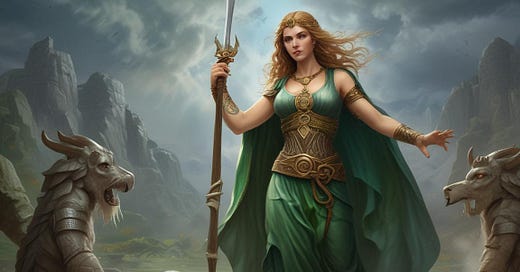Andrasta is an ancient Celtic goddess who was worshipped in Britain before the Roman conquest. She is known as the British war goddess and is closely associated with warfare and victory.
In ancient Celtic mythology, Andrasta is the daughter of the Tuatha De Danann goddess, Danu. She is believed to have been born from a single egg, and her name means "Invincible One". According to legend, she was a fierce warrior who led her people in battle against their enemies.
Andrasta is an important figure in modern paganism and Wicca.
She is associated with strength, success, and courage. Many pagans and Wiccans honour her with offerings and invoke her in prayers and spells related to warfare, victory, and protection.
She is a powerful goddess and represents the power of female warriorship. She is an empowering force and a reminder that women can be powerful and effective leaders and warriors. She is a symbol of hope and strength, and a reminder to never give up in times of challenge.
Andrasta is also a popular figure in literature, television, and film.
She has been featured in books such as The Mists of Avalon by Marion Zimmer Bradley, and television shows like Xena: Warrior Princess.
Many neopagan sources describe the hare as sacred to Andraste.
This idea seems to be extrapolated from the passage in Dio Cassius in which Boudica releases a hare from her gown:
"Let us, therefore, go against [the Romans], trusting boldly to good fortune. Let us show them that they are hares and foxes trying to rule over dogs and wolves." When she [Boudica] had finished speaking, she employed a species of divination, letting a hare escape from the fold of her dress; and since it ran on what they considered the auspicious side, the whole multitude shouted with pleasure, and Boudica, raising her hand towards heaven, said: "I thank you, Andraste, and call upon you as woman speaking to woman ... I beg you for victory and preservation of liberty."
Book of Roman History by Cassius Dio 211AD
The hare's release can be thought of in terms of divination, with an augury drawn from the direction in which it runs. This appears to be similar to the Roman methods of divination which ascribe meaning to the directions from which birds fly, with the left side being unfavourable (sinistra) and the right side favourable.
Alan /|\
Have you subscribed to The School of Mystery and Magick Blog (its free)?




